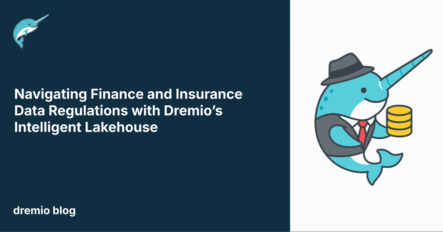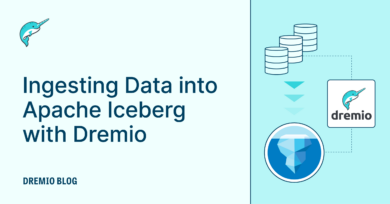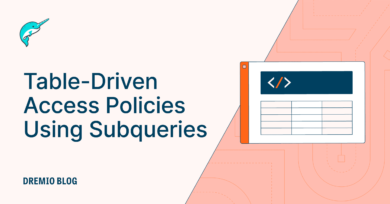11 minute read · September 17, 2025
Navigating Finance and Insurance Data Regulations with Dremio’s Intelligent Lakehouse
· Head of DevRel, Dremio

In the finance and insurance industries, data is both an asset and a liability. Every transaction, policy, claim, and customer record carries not only business value but also heavy regulatory obligations. Institutions operate under a web of global, federal, and state rules, from GDPR, CCPA, and PCI DSS to industry-specific mandates like Dodd-Frank, SOX, NAIC Model Laws, and Basel III. Compliance is not optional; it’s existential. Failure to secure sensitive financial or policyholder data can lead to multimillion-dollar fines, reputational damage, and loss of customer trust.
Yet, despite these pressures, many organizations still struggle with siloed systems, manual reporting processes, and fragmented governance that make regulatory alignment both complex and costly. What these firms need is a secure, compliant, and high-performance data platform that keeps pace with evolving regulations while enabling real-time analytics and innovation.
This is where Dremio’s Intelligent Lakehouse Platform comes in. By combining enterprise-grade security, fine-grained governance, open standards, and accelerated query performance, Dremio helps financial and insurance institutions transform regulatory compliance from a burden into a competitive advantage.
The Regulatory Landscape in Finance
Financial services organizations operate under some of the strictest data regulations in the world. Banks, investment firms, and payment processors must comply not only with broad privacy frameworks like GDPR in Europe and CCPA in California, but also with sector-specific rules that govern how financial data is stored, secured, and shared.
In the United States, agencies like the SEC, FINRA, CFTC, and the Federal Reserve enforce a complex web of obligations. These range from Sarbanes-Oxley (SOX), which requires preservation and transparency of financial records, to Dodd-Frank, which demands tighter cybersecurity controls and auditability. Standards like PCI DSS further raise the bar by mandating encryption and strict access controls for payment data, while AML and KYC regulations require banks to continuously monitor customer activity for suspicious behavior.
Globally, regulations such as Basel III, MiFID II, and GDPR add layers of requirements for risk management, investor protection, and personal data privacy. These mandates often overlap and vary by jurisdiction, creating a compliance landscape that is both broad and fragmented.
For financial institutions, this reality means compliance cannot be treated as a checklist, it must be a continuous, built-in capability. Platforms that lack fine-grained governance, encryption, or comprehensive audit trails struggle to keep up, putting institutions at risk of regulatory penalties and reputational damage.
The Regulatory Landscape in Insurance
The insurance industry faces a unique set of compliance challenges because it collects and analyzes enormous volumes of sensitive policyholder information, health records, financial data, and personally identifiable information (PII). As insurers increasingly leverage big data, machine learning, and predictive analytics, regulators have responded with strict rules to ensure consumer protections and prevent misuse.
In the United States, state regulators play a key role through the National Association of Insurance Commissioners (NAIC). The Insurance Data Security Model Law (#668) requires insurers and other licensed entities to establish comprehensive cybersecurity programs, oversee third-party service providers, and notify regulators in the event of a breach. Complementary model laws, such as the Insurance Information & Privacy Protection Act (#670) and the Privacy of Consumer Financial and Health Information Regulation (#672), set requirements for safeguarding policyholder data and maintaining transparency in how that data is used. As of 2025, more than half of U.S. jurisdictions have adopted some form of these NAIC models, signaling an industry-wide shift toward proactive data governance.
Globally, insurers must also navigate frameworks like GDPR in the EU, LGPD in Brazil, and IFRS 17, which emphasizes transparent and accurate financial reporting. Regulators in regions such as the UK (FCA) and India (IRDAI) require insurers to maintain strong data-governance practices, including data minimization, masking, and robust audit trails. Together, these rules form a dense and often overlapping compliance landscape that forces insurers to take a “compliance by design” approach.
For insurers, compliance isn’t just about avoiding fines; it’s about protecting customer trust. Policyholders expect their data to remain private, secure, and used responsibly. Failing to deliver not only triggers regulatory penalties but can damage brand credibility in a market where trust is central to long-term success.
Try Dremio’s Interactive Demo
Explore this interactive demo and see how Dremio's Intelligent Lakehouse enables Agentic AI
The Challenges of Building Compliant Data Platforms
For financial institutions and insurers, compliance is not just a box-checking exercise, it’s an ongoing operational challenge. The combination of regulatory complexity, massive data volumes, and performance expectations creates several obstacles that legacy systems often fail to overcome.
1. Fragmented Data and Siloed Systems
Banks and insurers typically manage data across dozens of systems: core banking applications, claims systems, trading platforms, CRM tools, and external vendors. This fragmentation makes it difficult to maintain a single source of truth, leading to inconsistent reporting and gaps in compliance monitoring.
2. Multi-Jurisdictional Regulations
Global organizations must simultaneously comply with regulations like GDPR, CCPA, Basel III, MiFID II, and NAIC model laws. Each jurisdiction imposes its own rules for data residency, retention, and security. Without centralized governance, ensuring adherence across all regions becomes nearly impossible.
3. Real-Time Performance Demands
Fraud detection, anti-money-laundering monitoring, and risk calculations depend on timely insights. Legacy warehouses and rigid ETL pipelines often cannot deliver sub-second analytics on growing data volumes, leaving organizations exposed to operational and compliance risks.
4. Manual and Error-Prone Compliance Reporting
Regulators expect detailed audit trails, lineage, and reporting. In many institutions, compliance reports are still generated manually or through brittle workflows, increasing the risk of errors and slowing response times to audits or investigations.
5. Customer Trust and Data Ethics
Beyond regulations, insurers and banks must safeguard their reputations. Consumers expect their personal and financial data to be used responsibly and transparently. Any lapse in governance not only triggers fines but erodes the trust that underpins customer relationships.
Why Dremio is the Ideal Platform for Finance and Insurance
The complex demands of financial and insurance data platforms require more than just secure storage, they demand governance, agility, and performance at scale. Dremio’s Intelligent Lakehouse Platform is purpose-built to meet these needs, enabling organizations to not only comply with regulations but also unlock new opportunities for innovation.
Built-In Governance and Data Sovereignty
Dremio gives financial and insurance companies complete control over their data. Fine-grained access controls, role-based permissions, and dynamic data masking ensure that sensitive information, like account numbers or health records, remains protected without creating redundant datasets. Every action is logged, delivering full audit trails and lineage that simplify regulatory reporting.
Enterprise-Grade Security
Dremio secures data at rest and in transit with encryption, while allowing customers to manage their own encryption keys. The platform is SOC 2 Type 2 and ISO 27001 certified, and HIPAA-ready, aligning with stringent compliance frameworks. Support for external identity providers like Okta and Azure AD, plus integrations with governance platforms such as Apache Ranger, Privacera, and Okera, ensures organizations can extend security policies across their data ecosystem.
Compliance by Design
From GDPR and CCPA to NAIC Model #668, Dodd-Frank, PCI DSS, and Basel III, Dremio’s architecture is designed with regulatory obligations in mind. Features like row-level and column-level security allow companies to enforce “least privilege” access while still enabling analysts and data scientists to get the insights they need. This makes it possible to meet compliance requirements without sacrificing agility.
High-Performance Analytics Without Movement
Unlike legacy warehouses that require heavy ETL pipelines, Dremio allows organizations to query data where it lives, whether in cloud storage, on-premises systems, or legacy databases. By eliminating data movement, Dremio ensures compliance with data residency rules while drastically cutting down costs and latency. Built on Apache Arrow and enhanced by intelligent query acceleration (reflections), Dremio delivers sub-second analytics at scale, critical for fraud detection, real-time risk modeling, and regulatory reporting.
Trusted by Industry Leaders
Global banks, insurers, and fintech companies already rely on Dremio to unify fragmented systems and accelerate their analytics. By combining cost savings with robust governance and compliance, these organizations are proving that secure, compliant platforms can also be agile and high-performing.
Conclusion: Turning Compliance Into Competitive Advantage
For financial and insurance companies, compliance is not just a legal requirement, it’s a strategic imperative. The overlapping patchwork of regulations, from NAIC Model Laws and HIPAA to Basel III, MiFID II, GDPR, and PCI DSS, makes it clear that data governance and security must be woven into the very fabric of an organization’s data strategy. At the same time, customers expect real-time experiences, transparent policies, and the assurance that their most sensitive information is being handled with care.
Dremio’s Intelligent Lakehouse Platform bridges these demands by combining enterprise-grade security, fine-grained governance, and sub-second analytics at scale. Instead of choosing between compliance and innovation, financial and insurance firms can achieve both. With Dremio, regulatory reporting becomes automated and auditable, sensitive data remains protected without slowing down business, and open standards future-proof data strategies in a fast-evolving landscape.
The result? Compliance shifts from being a burden to a differentiator, empowering firms to build trust, reduce costs, and move faster in delivering new products and services. For finance and insurance leaders looking to modernize their data platforms, Dremio offers a secure foundation that keeps pace with regulations while unlocking the full value of data.
See Dremio’s Intelligent Lakehouse Features First Hand by Signing up for a Workshop.


